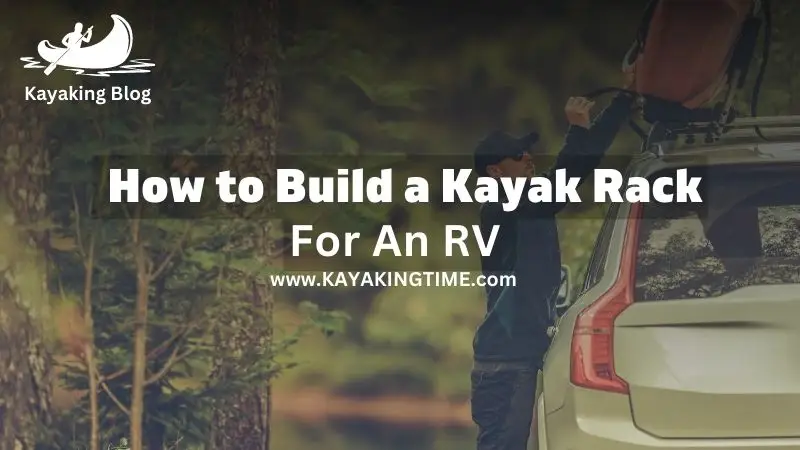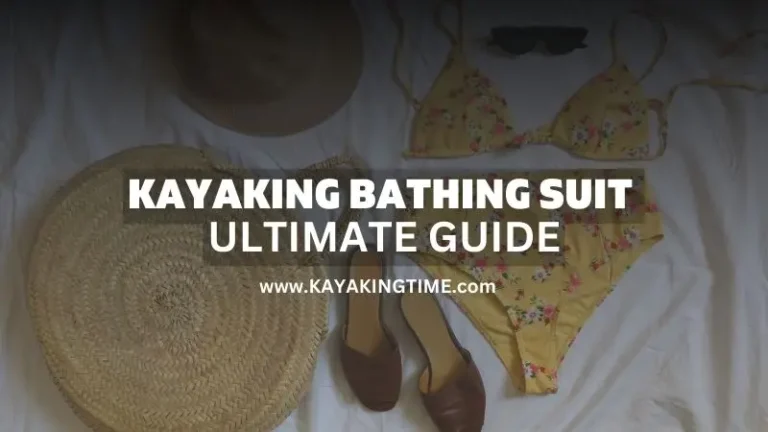How to Build Vertical Kayak Rack for RV Ladder and Campers – DIY Recpro Kayak Rack for Camper Van
If you’re an outdoor enthusiast who loves kayaking and exploring new destinations with your RV, having a kayak rack is a must. A kayak rack allows you to bring your kayak along on your adventures without taking up valuable space inside your RV.
In this blog, we’ll discuss how to build a kayak rack for an RV, including understanding the benefits, assessing your RV’s roof compatibility, choosing the right type of rack, and step-by-step instructions for building and installing your DIY kayak rack.
So let’s get started!
Benefits of a Kayak Rack for an RV
First thing first you should know how important and beneficial a Kayak rack is for your RV since A kayak rack for your RV offers several benefits, here is I list of some of the benefits for you:

- Saving space inside your RV for other essential items
- Keeping your kayak secure during travel
- Protecting your kayak from damage
- Allowing you to bring your kayak on all your adventures
Factors to Consider Before Starting to Build a Kayak Rack For an RV
1- Assess Your RV’s Roof for Kayak Rack Compatibility
Before you start building your kayak rack, it’s important to assess your RV’s roof to ensure it can support the weight of the rack and kayak.
Check your RV’s owner’s manual for information on the roof’s weight capacity and any restrictions on installing a kayak rack.
2- Choose the Right Type of Kayak Rack
There are several types of kayak racks available, including:
- J-cradles: These racks hold the kayak on its side, allowing for more storage space on your roof.
- Stackers: These racks allow you to stack multiple kayaks on top of each other.
- Saddles: These racks cradle the kayak’s hull, providing a secure and stable hold.
Consider your specific needs, such as the number of kayaks you want to carry and the available space on your RV’s roof, when choosing the right type of kayak rack.
3- Gathering the Necessary Tools and Materials
To build a DIY kayak rack, you’ll need the following tools and materials:
- PVC pipes
- PVC connectors, elbows, and T-joints
- Brackets and mounting hardware
- Pipe cutter or hacksaw
- Drill
- Wrench
- Measuring tape
- Foam padding or pool noodles
- Straps or bungee cords
Step-by-Step Guide to Building a DIY Kayak Rack

Step 1: Measure the dimensions of your kayak and the available space on your RV’s roof.
Before you start building your DIY kayak rack, it’s important to measure the dimensions of your kayak and the available space on your RV’s roof.
This will help you determine the appropriate size for your kayak rack and ensure that it fits your kayak properly.
Step 2: Cut the PVC pipes to the desired lengths based on your measurements.
Using the measurements you took in the previous step, cut the PVC pipes to the desired lengths. These pipes will serve as the main structure of your kayak rack, so it’s crucial to cut them accurately.
A hacksaw or PVC pipe cutter can be used for this task.
Step 3: Assemble the PVC pipes using connectors, elbows, and T-joints to create the frame of the kayak rack.
Using PVC connectors, elbows, and T-joints, assemble the cut PVC pipes to create the frame of your kayak rack.
Follow your design or plan to ensure proper alignment and stability. Dry-fit the pieces together first to make sure everything fits correctly before moving on to the next step.
Step 4: Attach brackets to the PVC frame for securing the kayak rack to the RV.
Attach brackets to the PVC frame that will be used to secure the kayak rack to the roof of your RV. These brackets should be positioned strategically to provide stability and support for the rack.
Use screws or other appropriate fasteners to securely attach the brackets to the PVC frame.
Step 5: Install the mounting hardware on your RV.
To install the kayak rack on your RV, you’ll need to install the necessary mounting hardware. This typically involves drilling holes into the roof of your RV and attaching brackets or tracks that will securely hold the kayak rack in place.
Make sure to follow the manufacturer’s instructions and use the appropriate tools for this step.
Step 6: Position the kayak rack on the RV and align it with the mounting hardware.
Carefully position the assembled kayak rack on your RV’s roof, aligning it with the previously installed mounting hardware. Take your time to ensure that the rack is positioned correctly and securely.
Step 7: Tighten the bolts and straps to secure the kayak rack to the RV.
Once the kayak rack is properly positioned, use the appropriate tools to tighten the bolts and straps that secure it to the RV. This step is crucial for ensuring the stability and safety of your kayak rack during transportation.
Step 8: Attach foam padding or pool noodles to the PVC frame to protect the kayak from scratches and damage.
To prevent scratches and damage to your kayak, attach foam padding or pool noodles to the PVC frame.
This will provide a cushioning effect and protect your kayak during transit. Use zip ties or adhesive tape to secure the foam padding or pool noodles to the frame.
Step 9: Secure the kayak to the rack using straps or bungee cords.
Finally, secure your kayak to the rack using straps or bungee cords. Make sure the kayak is centered and properly secured to prevent any movement or shifting during travel.
Double-check the tightness of the straps or cords to ensure a secure fit.
By following these step-by-step instructions, you can build your own DIY kayak rack for your RV, providing a convenient and safe way to transport your kayak during your outdoor adventures.
Installing and Securing the Kayak Rack is Very Important!
Installing and securing the kayak rack is very important. Once you’ve built your kayak rack, carefully position it on your RV’s roof and align it with the mounting hardware.
Tighten the bolts and straps to secure the rack to the RV. Double-check that the kayak rack is stable and secure before placing your kayak on it.
Tips for Maintaining and Using Your Kayak Rack
- Regularly inspect your kayak rack for signs of wear or damage.
- Tighten any loose bolts or straps as needed.
- Remove any debris or dirt from the rack to prevent scratches on your kayak.
- Always secure your kayak properly before hitting the road.
Safety Considerations
- Ensure your RV’s roof can support the weight of the kayak rack and kayak.
- Double-check the stability and security of the kayak rack before each trip.
- Make sure the kayak is securely fastened to the rack to prevent it from falling during travel.
- Be aware of any height restrictions when driving with a kayak rack on your RV.
Can a DIY Kayak Rack Be Easily Removed or Disassembled When Not in Use?
Yes, depending on the design and attachment method, a DIY kayak rack can be made to be easily removable or disassembled when not in use.
This can be beneficial if you only need the rack for specific trips or if you want to remove it for storage or other purposes. Consider using quick-release fasteners or other removable hardware options when building the rack to allow for easy disassembly or removal when needed.
Here are some of the benefits of a removable or disassemblable kayak rack that you may find useful!
Benefits of a Removable or Disassemblable Kayak Rack
A removable or disassemblable kayak rack offers several advantages:
1- Space-saving
When not in use, the disassembled components can be stored in a compact space, freeing up valuable room in your garage or storage area.
2- Portability
A disassemblable rack can be transported easily to different locations, making it convenient for those who frequently travel with their kayaks.
3- Adaptability
A modular design allows you to reconfigure your kayak rack as needed, accommodating different types of kayaks or storage requirements.
Conclusion – Building Kayak Rank For An RV
Building a kayak rack for your RV is a rewarding project that allows you to bring your kayak along on your adventures.
By understanding the benefits, assessing your RV’s roof compatibility, choosing the right type of rack, and following our step-by-step guide, you can create a reliable and secure kayak rack for your RV.
Remember to always prioritize safety and maintain your kayak rack to ensure it lasts for many adventures to come. Happy kayaking!
FAQs | How to Build a Kayak Rack for an RV
q. What tools do I need to cut PVC pipes for a kayak rack?
To cut PVC pipes for a kayak rack, you can use a hacksaw or a PVC pipe cutter. These tools will allow you to accurately cut the pipes to the desired lengths for your kayak rack.
q. What type of brackets should I use to secure a kayak rack to an RV?
The type of brackets you should use to secure a kayak rack to an RV will depend on the specific design of your kayak rack and the mounting options on your RV. Common bracket options include L-shaped brackets, U-shaped brackets, or custom-designed brackets that can be attached securely to the PVC frame and the RV’s roof.
q. What is the mounting hardware needed for a DIY kayak rack on an RV?
The mounting hardware needed for a DIY kayak rack on an RV typically includes screws or bolts, washers, and nuts. Additionally, you may need brackets or tracks specifically designed for attaching the kayak rack to the roof of your RV.
q. How do I install mounting hardware on an RV for a kayak rack?
To install mounting hardware on an RV for a kayak rack, you’ll need to determine the appropriate location for the hardware on the roof of your RV. Use a drill to create holes for the screws or bolts, and then attach the brackets or tracks securely using the provided hardware. Follow the manufacturer’s instructions for the specific mounting hardware you are using.
q. How do I align a kayak rack with the mounting hardware on an RV?
To align a kayak rack with the mounting hardware on an RV, carefully position the assembled rack on the roof of your RV. Make sure the brackets or tracks on the rack align with the corresponding mounting hardware. Take your time to ensure proper alignment and adjust as needed before securing the rack.
q. What are the best methods to secure a kayak rack to an RV?
The best methods to secure a kayak rack to an RV include using bolts or screws to fasten the rack’s brackets or tracks to the RV’s roof. Additionally, using straps or bungee cords to secure the kayak rack tightly to the RV will provide added stability during transportation.
q. What materials can I use to protect my kayak from scratches on a DIY kayak rack?
You can use foam padding or pool noodles to protect your kayak from scratches on a DIY kayak rack. Attach them to the PVC frame using zip ties or adhesive tape, ensuring that the kayak’s contact points are well-padded.
q. How do I attach foam padding or pool noodles to a kayak rack frame?
To attach foam padding or pool noodles to a kayak rack frame, wrap them around the PVC pipes at contact points where the kayak will rest. Use zip ties or adhesive tape to secure the foam padding or pool noodles to the frame, ensuring a snug fit that provides adequate cushioning for your kayak.
q. What are the recommended straps or bungee cords to secure a kayak on a rack?
For securing a kayak on a rack, it is recommended to use high-quality straps or bungee cords specifically designed for securing outdoor equipment. Look for straps with durable webbing and strong buckles or cam buckles for easy tightening. Bungee cords with reliable hooks or clips are also suitable for securing the kayak. Make sure the straps or bungee cords have sufficient length to wrap around the kayak and the rack, providing a secure and tight hold.
q. Are there any safety considerations when building and using a DIY kayak rack for an RV?
Yes, safety should always be a priority when building and using a DIY kayak rack for an RV. Consider the weight capacity of the rack and ensure it can safely support the weight of your kayak. Double-check all connections, brackets, and mounting hardware to ensure they are secure before traveling. Regularly inspect the rack for any signs of wear or damage. Additionally, ensure that the kayak is properly secured to the rack using reliable straps or bungee cords and that it is well-balanced to prevent shifting or instability during transit.
q. Can a DIY kayak rack be customized to fit different kayak sizes?
Yes, one of the advantages of building a DIY kayak rack is that it can be customized to fit different kayak sizes. By adjusting the dimensions and spacing of the PVC pipes, you can accommodate kayaks of various lengths, widths, and heights. Ensure that you make accurate measurements and consider the specific dimensions of your kayak to create a properly fitting rack.
q. Are there weight limitations for a DIY kayak rack on an RV?
Yes, there are weight limitations to consider when building and using a DIY kayak rack on an RV. The weight capacity will depend on the materials used, the design of the rack, and the mounting options on your RV. It is important to adhere to the weight limitations specified by the manufacturer of the rack components and to ensure that the rack is securely attached to the RV’s roof.






